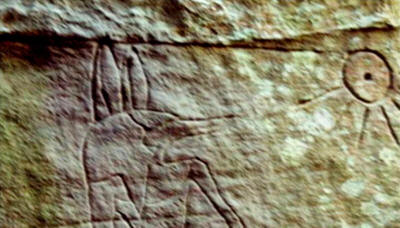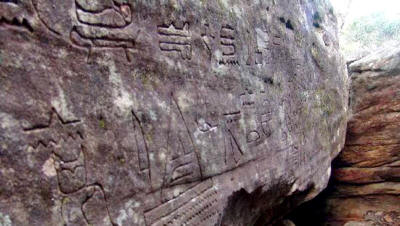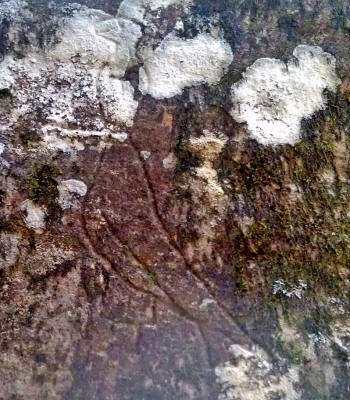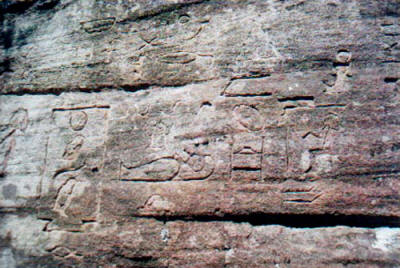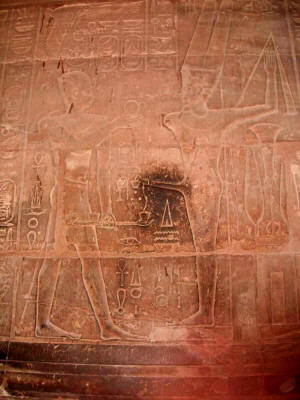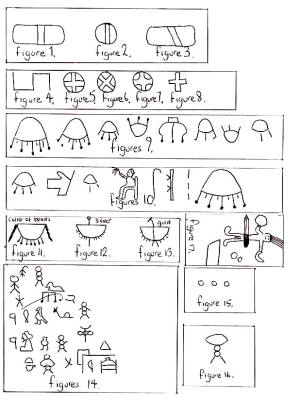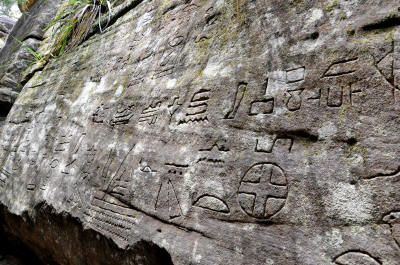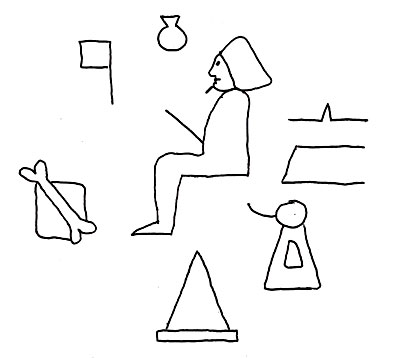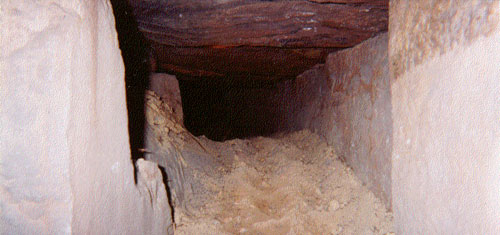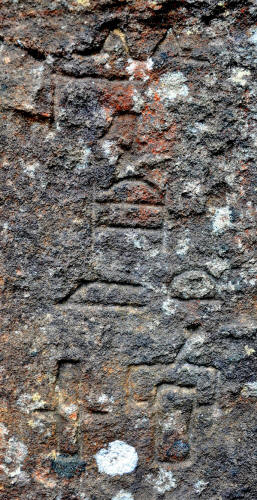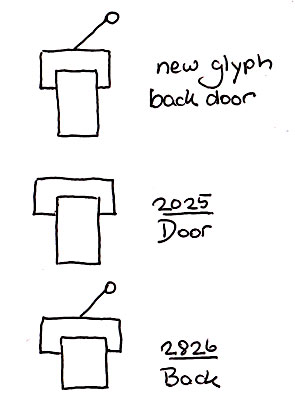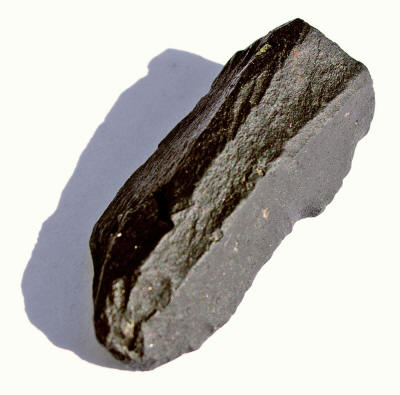|
Guest Writer for Wake Up World
The Egyptian Connection 29 October 2012
Ancient Egyptian Hieroglyphs discovered outside Sydney Australia.
Photo courtesy of
Steve Strong and Dr. Hans Dieter von Senff
The Kariong Glyphs site is the most argued over and controversial archaeological site in Australia.
Decried as utterly bogus by authorities
and skeptics, it is an archaeological ‘poison chalice.’ My
colleagues and I have been denounced as “dumb and dumber,” “liars,”
motivated by “money” while working in an “unscientific” manner
driven by an unstated “agenda,” simply because we find fault in
every explanation of a hoax and merit in the notion that some of
hieroglyphs were carved by ancient Egyptians.
These walls have close to 300 engravings. Some claim they are a random mixture of ancient scripts done recently, others believe they are a genuine example of the earliest style of Egyptian writing (Proto-Egyptian).
There are so
many rumors and stories accounting for their presence, too many to
canvas now, but there are a couple of explanations that seem to be
the most convenient, and have become the “accepted versions”.
According to National Parks and Wildlife
Service, the engravings were created no earlier than 1983.
Once we began filming an interview with the two Original spokespeople for the site (Egyptians in Australia-Part 2 - far below video), everything changed.
Until that day we had listed the Kariong
Glyphs as ‘number 52′ in our collection of 60 odd pieces of evidence
substantiating an ancient Egyptian presence in Australia. After
speaking to Aunty Beve and David Fitzgerald, the glyphs have been
repositioned at ‘number 1′ with daylight running a distant second.
She is the keeper of the women’s stories and one of the very few who has the right to speak on Original Lore and Dreaming stories in this tribal region. Her word on such matters can not be challenged.
Up until now, whenever asked about an
Egyptian involvement in creating the hieroglyphs in the area, Aunty
Beve always refused to make any public statement.
She also explained why many of the carvings look incredibly fresh and well tended, and certainly don’t exhibit thousands of years’ wear and tear or build up of rock varnish, as one would expect;- In ancient times the women would use their urine to clean the engravings on a regular basis.
Aunty Beve went even further in noting there are other carved hieroglyphs in the region (of which we are aware of two) that are “far older” and are “not Egyptian,” but were created by Australians!
Could this mean the Egyptians learnt the
art of writing with hieroglyphs whilst in Australia while under
Original tutelage? Ancient Egyptian Hieroglyphs discovered outside Sydney Australia.
Photo courtesy of
Steve Strong and Dr. Hans Dieter von Senff
While the concept of ‘writing beginning in Australia’ may seem somewhat radical, it isn’t.
Respected academics including Lesley Maynard and Robert Bednarik have stated that the engraved symbols found at Panaramitee (SA) may be the initial inspiration behind all forms of written communication.
Bednarik conducted a ‘straw poll’ to test the likelihood that Original people “invented” the first alphabet/codified set of symbols. Bednarik was convinced that some of the art of other continents resembled the Panaramitee.
He sent out copies of seven unlabelled drawings of engravings (mainly circles and arrow-like marks resembling bird tracks) and asked eight rock art specialists to identify whether they were Panaramitee style or not.
In fact they were all from North and South America, Africa and Europe. The score of wrong answers was an abysmal 98%, which led Bednarik to suggest that,
With the benefit of hindsight and Aunty Beve’s guidance, it is now
obvious Bednariks’ second option of “a world wide trend” was indeed
the answer he sought.
David Fitzgerald was a “building contractor and unofficial sites finder” for National Parks and Wildlife Services (NPWS) Brisbane Waters, and is a blood descendant of the mighty warrior Pemulwuy.
He first became aware of the site in
1978, at least 5 years before NPWS claim they first knew of the
hieroglyphs. David was very open in acknowledging there was a
deliberate cover-up, and that it took some haggling by him (and even
a degree of “bribery”) before they showed him the two walls in 1978.
The rest was submerged under tonnes of litter.
According to David the collection of trees, branches, rocks and debris had built up “over decades.” David and his co-workers, under the direction of NPWS, took “two full days to clean up.”
This advanced state of disrepair casts serious doubt upon the most popular version of the supposed skullduggery that led to this hoax being created. The story goes no more three years before this massive clean-up occurred.
Alan Dash, a surveyor working for Gosford Council, found a ‘deranged Yugoslav’ exiting the two walls with chisel in hand and assumed he was responsible for the exotic graffiti.
Dash then walked in and examined the
walls freely with barely a twig beneath his feet. Outside the
incredibly remote possibility that tonnes upon tonnes of debris
accumulated on this site in less than a thousand days, one of these
accounts is plainly wrong.
But as is often the case, many lies have their genesis in a truth, no matter how convoluted. Yes, the date was 1983. And yes, students from Sydney University were on site and standing between the walls. David should know - he took them there!
But the notion that these same students then engraved the entire gallery had, at least, a small fingernail of truth within; one of the students began scratching at the a glyph with her fingernail, David was far from impressed and made it clear she stop immediately.
Soon after he escorted them from the
site.
David was told “to forget about it” and “not to mention a word to anyone.”
Everything was clothed in secrecy, and
until rumors and talk quickly spread, it was hoped the whole
inconvenient Egyptian affair would disappear and fade back into the
Australian scrub. When responding to my question in relation to what
avenues were available to him to counter the lies and denials coming
out of NPWS and further up, he pointed out if he did object any
further he would be “in danger of losing any contracts.”
Aunty Beve and David’s testimony is the
final word - some of the glyphs on the Central Coast of NSW are
Egyptian. Whatever the unnamed ‘deranged Yugoslav’ chiseled, Alan
Dash saw, or devious students engraved is just the White-fella’s
take on history… a sorry story that has been blindly accepted for
centuries.
King Bungaree was a highly respected Original Elder of the region, and in 1896 a compendium of his Dreaming stories and local knowledge was published. Reference was made by him to a Kariong Dreaming story about “two brothers” who came here in “great canoes.”
Misfortune befell them and one was
“bitten by a snake,” died and was “buried“ near the walls.
The scribe for Nefer-Djeseb and Nefer-Ti-Ru made note of being “stranded in this wretched land” and that their chances of returning were negligible.
They experienced “drought”, and for
reasons unstated Nefer-Ti-Ru made his way “westward” for “two
seasons.” Unfortunately, while returning, he was “bitten” not once
but “twice” by a “snake”, died, and was buried near the two walls.
Johnson went to Egypt and presented his
research to the Director General of the Cairo Museum, Dr. Abu
Dhia Ghazi, who confirmed his interpretation was correct.
We are convinced the younger set of engravings is possibly 4,770 years old, but the older narrative could date back much, much further. When my colleagues and I ask for guidance on how far back and from where the inspiration came, the response is always the same; every tribal group we have met or know of carries one constant, one Dreaming story that transcends boundaries: the Seven Sisters, Pleiades.
On those walls, we suspect this same story, celestial place and direct genetic involvement is recorded in stone.
For now enough of Kariong.
I could discuss it in more detail, but the engravings are too detailed and need 3000 words for the briefest coverage. In the November/December edition of New Dawn we go into more detail and separate the two accounts, one of earthy origin and one from the stars.
Our aim here was to establish the
authenticity of the site, and because of this truth these two
sandstone walls and associated archaeology rewrite Australian and
world history, pose questions about why the Egyptians came here, and
challenge fundamental assumptions made about the role the Australian
Original people had in global pre-historic times and genetics.
In many of our articles and books we
have presented a bounty of evidence substantiating an actual
Original presence in many locations, and of course Egypt has been a
prominent destination discussed in detail in our first book
“Constructing a New World Map.”
One mummified corpse, along with a canoe used in these rituals, was stolen from Darnley Island (Torres Strait) in 1875 by members of the Shervert expedition.
Momentarily ignoring the dubious ethics of such desecration, it is worth noting that,
What needs to be understood is that the Original influence in Egypt is not just related to higher realms of the esoteric, limited to a select few, but had spread throughout the landscape. In the eyes of most Australians, where there are gum leaves so too koalas, kangaroos and sundry native species.
That being the case, the Cairo Times (1982) report that,
In what is possibly the most famous example of a long-standing Australo-Egyptian formal liaison, the discovery in King Tut’s tomb of a dozen wooden boomerangs, each of a unique design and typical Original patterning, should have caused a huge unrest within Australian academic circles. Instead it was met with a deafening silence.
Is this apathy? Or an inconvenient truth
of massive proportions? [3] [4] [5]
As things stand it is a work in progress.
Ancient Egyptians in Australia None of this can be found in text books or school curriculum in any part of Australia.
Egyptian Presence in Australia
What makes me sad is that this glaring omission from Australia’s history does not stand alone; it is merely one chapter among many.
Equally, it needs to be acknowledged that the Egyptians were but one of many nations that made contact with the First Australians.
...all walked on these shores well before Cook.
And all, bar the British, stayed for a period of time and left when asked.
So much has been lost and stolen since the invasion, but in the spirit of Wirritjin (Black-fella White-fella Dreaming) the Original keepers of lore are revealing secrets never before shared, of a past and a heritage that was never forgotten - just hidden until the time is right.
Egyptians in Australia - Steven Strong September 20, 2012
Reading Between the Walls and Lines The Ancient Australian-Egyptian Connection 12 November 2012
Undeniably many characters are
Proto-Egyptian, while quite a few are not. But the real problem here
is not on the wall but within its observers. The critics are limited
by their ethno-centric blinkers, and could never reverse their
perceptual parameters to consider the possibility that some of these
engravings were actually carved by Original hands.
With Aunty Beve adamant the older hieroglyphs were not Egyptian but Australian, and distinguished linguist Atilla Flinck absolutely convinced the Australian Root Language is the foundation base and geographic origin from which all other languages evolved, it starts to become obvious why the Egyptians (and others) sailed to this distant southern continent so long ago.
They came to Australia as apprentices, seeking spiritual wisdom, to be educated by the people who spoke and wrote the first word.
The historical truth known by ancient
Egyptians, and others, was that this place and the nomads who
inhabited it provided the inspiration for all the varying accounts
of the ‘Garden of Eden’.
Johnson re-sparked the debate and controversy surrounding the Kariong glyphs when he provided his interpretation of these carvings; he believes that the script is the earliest form of Proto-Egyptian hieroglyph.
More importantly, once he realised the massive implications of this analysis, Johnson had the foresight to make direct contact with the Director General of the Cairo Museum, Dr. Abu Dhia Ghazi.
After reviewing Johnson’s
interpretations, Dr. Ghazi was more than satisfied that Johnson was
correct, and his endorsement (along with his immense wisdom and
integrity) indicates that Basic Hieroglyphica is the best of all
publications from which to begin our attempt to fathom the ‘who,
when and what’.
But where we part company relates to timing.
Some of the engravings look unworn and ‘recent’, and skeptics therefore see this assortment of relics, shafts and hieroglyphs as bogus. But the interviews we held with Darkinjung Elder Aunty Beve Spiers and Mr. David Fitzgerald (formerly of National Parks and Wildlife Services) amply explain why the carvings look so new; they shared knowledge of a recently-fallen rock roof which for centuries protected all the writings and provided close to a complete seal from the elements.
They also described how the liberal
application of Original women’s urine to the glyphs was used to aid
their preservation.
That part is easy. But spread throughout
the walls, with Ray’s manual as our guide, my colleagues and I found
a pattern emerge that set us off on a tangent - one we had
deliberately kept at arm’s length until now.
The narrative - which names Nefer Djes-eb, his brother and their Egyptian lineage, and the snake encounter and encryption - is undoubtedly Proto-Egyptian, and we believe was written by Nefer Djes-eb’s scribe.
But when we separate from the overall
mix the carvings clustered around the tale of the two brothers,
barely 50% of the remaining engravings are a comfortable match, and
close to one third show nothing that is remotely similar.
Dr. Hans stated in his paper that,
With some symbols, educated guesses and assumptions were made.
But for other glyphs, nothing was available for comparison, so Hans made note of the selective omissions and alerted the reader that,
The number is not small; it is in the dozens.
And that fact alone presents a major
obstacle when defining their content. Many glyphs have a variety of
meanings, and the positioning of associated glyphs makes all the
difference, even more so when the reader is unable to determine any
meaning.
Could it be that Proto-Egyptian hieroglyphs evolved from the much more ancient local script, and that once this form of script left Australian shores the many differences and omissions emerged - reflecting the differences in culture and lifestyle?
This would explain why there are two
accounts and hands at work on these walls, and what motivated
Egyptians (and others) to sail to these shores in ancient times.
We are extremely thankful he took the time to contact us, as the comparison he supplied illustrates the antiquity of the Australo-Egyptian accord, and the initiator.
We have found repeated references to a more ancient civilization, and in both cases the older script is used.
Even though Ray Johnson’s Proto-Egyptian is derivative of the more ancient style which may well be Australian, it still provides links and potential clues. Such is the case with Figure 1 (shown below), which seems a fairly non-descript icon that has no identical match.
The two closest glyphs in appearance
(Figures 2 and 3 below) can be merged to create an exact copy of the
engraving on the wall, and each symbol has virtually the same
definition; the first represents a “prehistoric building,”
[iii] the second is meant to depict “ancient ruins, ancient
city.” [iv]
The problem is that “land’s end” [vii] is a indeed a four armed cross but it was never enclosed with a circle.
The circle was deliberately placed to seal the glyph on the wall, and as such, should not be assumed to define “land’s end.” [viii] However, there are three other candidates and each has a four-armed cross, one with a circle and four armed cross slightly off-centre (Figure 6 below), another is almost the same as that on the wall but the arms of the cross are slightly curved (Figure 7 below) and the other is exactly the same as “land’s end” (Figure 8 below).
The only glyphs that have both a circle and a four armed cross represent either “city, community, settlement” [ix] (Figure 6 below), or “town, village, hamlet” [x] (Figure 7 below), while the glyph identical to “land’s end” can also depict a “fire festival.” [xi]
There are, depending on perspective and ‘blinkers’, up to 8 glyphs (Figures 9 below) that fall into the ‘UFO’ category. This label is not our term, but is the common label used by the general public, and describes a series of engravings which have been lambasted by doubters and used as evidence that the entire gallery is bogus.
The ‘UFO’ icons have nine legs, seven, five and three legs, and all are of differing shapes and sizes.
The deliberate variation in features is
in contradiction with any standard ‘jewellery’ text, which demands
uniformity. Every other repeated hieroglyph maintains the same form
and size, and in this respect, these glyphs stand apart.
We have seen other interpretations of this line, but all omitted the first four symbols. The deletion of two UFO glyphs, thus leaving one inconvenient inter-stellar craft to negotiate, is a crucial error in interpretation.
Even with two UFO’s missing in action, the offending third craft and four accompanying glyphs have been misread as being “O holy shining ones,” [xii] - assuming that the,
However no Egyptian scribe was allowed such poetic license, and to claim that these objects are actually pieces of jewellery is manifestly false.
All jewellery glyphs (Figures 11-13 below) have a lower case semi-circle sealed off with a straight line, while all UFO glyphs have an upper case semi-circle/ellipse with no straight line. The positioning, size and number of arms are markedly different, and the reality is that there is much more separating than connecting the two symbols.
Translation of that particular line, or rather the small section chosen, needs to factor in the presence of three distinct UFO icons and should therefore read,
We agree on this distant location simply because, in Australia, there are quite literally no other candidates on offer. Aboriginal ‘Dreaming’ stories told throughout the country constantly refer to Pleiades (the Seven Sisters) as do many Elders and Keepers of Lore.
Time after time, Pleiades has been nominated as the location from which their ancestors originated.
As
such, it is possible their Pleiadean ancestors may have actually
been involved in the genetic development of one species of hominid:
Homo Sapiens.
There is nothing that comes close to this representation in standard text, but there is one other known symbol that does have three circles (Figure 15 below) and is used to define “chemical, mineral.” [xiv]
Granted they are aligned horizontally and spaced apart, but there is nothing else remotely similar.
Could it be the object or being depicted here has been created through some sort of chemical or genetic process? In what only adds to the possibilities, just below are two other three circled figures and both of these have also been given arms. Close by is yet another sequence of three circles, and on this occasion they are in the proper horizontal alignment but are bisected by a staff/sceptre.
Is it possible this actually describes
the manipulation of the hominid gene?
The two icons appearing like small flags
denote “God,” [xv] another resembling a snake denotes
“father,” [xvi] the seated person represents “majesty,”
[xvii] and together they highlight the potential that
there is something scientific and esoteric afoot.
We believe there is one misread glyph that tips the scales in the affirmative. Just below the lowest three circled person is a figure, apparently human, that many commentators have mistaken for “endure.” [xviii]
The symbol for endure (Figure 16 below) is made up of two legs, two circles with an ellipse on top.
But on the wall the ellipse is in the middle, positioned where the figures waist would be. With all the implied genetic manipulation above, could this figure actually depict the bearing by women (of either alien or Original stock) of the genetically engineered species?
The figure certainly appears very
pregnant, rather than a depiction of ‘endurance’.
My colleague Sonya James forwarded on photographs of the glyphs to Yousef and Patricia Awyan, Co-Directors of The Khemit School of Ancient Mysticism in Egypt.
It was Patricia’s response that led us to question whether the small section we accepted to be Proto-Egyptian was actually the younger form of script.
As do we.
But the mention of the “seed of life”
was unexpected, and only reinforced our belief that the occurrence
of genetic manipulation is communicated on the Kariong glyphs.
Together, these glyphs and expert analyses go some way towards
explaining why Elder Aunty Beve repeatedly referred to this tribal
estate as the “beginning country?” [xix]
At Egypt’s Temple of Luxor, carved into the outside wall of the ‘Holy of Holies’, is a series of engravings that graphically illustrate the very first step taken toward the creation of a new genetically improved hominid. My colleagues and I believe this is a record of the collection of sperm from ‘Sky-Heroes’ with the assistance of a quite unusual device - consisting of a cup and some sort of staff/sceptre.
In what only adds to the possibility of the depiction of such procedures, there are two cups attached to this elaborate shaft. One receptacle is obviously used to collect sperm.
Could it be the other was used to store
the human egg?
Original Elders and custodians of lore and history from all over the Australian continent have made it clear that Pleiades forms a central part of their ancestry, and spoke of older Original writings which could be interpreted (as we have) to be of Pleiadean inspiration.
We have learned of many sites in various locations that affirm there was an ancient Egyptian presence in Australia.
And although ‘white’ experts dismiss
such notions as ridiculous, plainly, someone is wrong.
Yesterday’s Mistakes, Tomorrow’s Salvation Ancient Egyptians in Australia 30 November 2012
I knew roughly how many people I had
invited and what each person could contribute to the day’s
expedition. But even so, it was a big group - and a final count made
it obvious the logistics of fitting the entire group in and around
the two ‘glyph walls was going to be challenge.
Genesis
I take this belief directly from the Dreaming, and from the mouths of the Original Elders themselves. In the words of respected Dhungutti Elder ‘Uncle’ Reuben Kelly:
Another Original custodian of lore, Burri, described what took place next,
There are also legends of a messiah-like
‘oracle’ (also depicted in the Kariong glyphs) cloaked in a diamond,
guiding and teaching many tribes.
So far, my colleagues and I have yet to
meet a tribe that doesn’t re-count the activities and journeys of
those Seven Sisters.
Further Hieroglyph
Readings
And our latest trip through the Kariong
site revealed several new observations of importance.
Found to the far right of the “genetic”
narrative, and slightly apart from the next section, the cluster of
eight ‘glyphs (Figure #1) describes who was responsible - and
perhaps even their motivation - for genetically modifying one strand
of hominid.
The flag nearby, which denotes “God”,
only confirms the majesty of the being or person depicted. And the
‘Dalek-like’ icon represents “oracle/sanctuary”, which strengthens
the sense of status and benevolence attributed to this being.
Although doubters deny the rectangle and
bone any legitimacy in Proto-Egyptian script, Raymond Johnson’s
Proto-Egyptian dictionary “Basic Hieroglyphica” (page 38, hieroglyph
1172) depicts the exact same rectangle and bone ‘glyph. Meaning
“heir, lot”, this ‘glyph represents ‘a heritage passed on’ - of
either an esoteric and genetic persuasion.
But there is more to this site than two
hieroglyph walls. Much more!… a fact that has been overlooked by the
skeptics and hoax theorists.
Rocks were strewn everywhere, some weighing hundreds of kilograms. And there right in the middle was a shaft leading straight down, 3 meters deep with tunnels running off in both directions (below video “Egyptians in Australia-Part 4”):
Gavin Bragg, an invaluable
member of our group - and a man who climbs into places I refuse to
venture - went it.
One is around 10 meters in length, but is very narrow and covered with debris and sand (see below). Then there is the main gallery, which Gavin describes as “big enough to park two cars”. One of the other tunnels runs on a different trajectory - sloping downwards.
But we are unsure of what it might
reveal, as the smell of methane was too overpowering for Gavin to
venture any further in.
And after inspecting these shafts, my colleagues and I - with one exception - share a common conviction:
Critics - including the skeptic in our team - generally attribute unique formations on this site to “bizarre” and “unusual” geology.
We agreed to disagree - for now.
But the
next site we found was met with awed silence. We located a second
set of hieroglyphs.
Until now, no-one even knew of these engravings, no-one has claimed responsibility and no-one has alleged that they are fake.
Immediately, three things stood out; they were smaller than the other ‘glyphs, very worn, and found in a protected location. The wall above was vertical but sloped outwards slightly thus ensuring the water run-off was not a factor, while the ledge in front shielded the site from direct sunlight and most winds.
The style and script is reminiscent of
the older panels on the walls, and is comprised of a matching ration
of Proto-Egyptian and non-Egyptian script.
This coincidence was not lost on me: the
opening section of 81 glyphs - of which 36 were an identical match -
also includes 44% Proto-Egyptian script. This may be due to pure
chance, but standing at this new site, I was aware that the
mathematics was consistent at both sites.
In ascending order:
The complexity and accuracy of the hieroglyphs leave no doubt that the many of the carvings are genuinely Proto-Egyptian. Other hieroglyphs have also been found in the area, which have never been claimed as part of a “hoax” theory.
A basalt chisel (see right) found on the site by Dr. Hans Dieter von Senff and Dan Collins was subsequently determined by a gemologist to have “most likely originated in Egypt”. Artifacts found in the area by Elder ‘Aunty’ Minnie Mace (of the Koa people) include human bone and a piece of jewellery depicting a person kneeling, arms outstretched.
Then there are all the Egyptian motifs
and Gods engraved into the rock platforms nearby….
The one variation to the story is that
the last Egyptian visitors showed little appreciation for the wisdom
they were offered and refused to leave - and were subsequently
ejected.
The NPWS marks important sites as
“hazardous”. It fills in newly discovered tunnels and caves with
solid rock. It ignores new evidence of historical importance. Most
importantly… it has never bothered to consult the Original
custodians of the area.
Cedar Point, NSW
The relevant Original parties must be in
agreement. The secret sacred men’s ceremonial site - where
initiation, shield and tree carving was conducted - was apparently
safe.
But rather than correct the paper-work
and acknowledge the site’s importance, NPWS prefers to exploit the
loop-hole... and continues to treat the site like a pile of rocks.
As Githubal Elder Kevin Boota pointed out:
The Githubal people will do their best
to protect this special location. And maybe, just maybe, they can
save it.
After all, they may be breaking sacred
Original law - and treating the Original peoples with disdain - but
they aren’t breaking White-fella law…
But this not a tale
of injustice and despair...
The site at Kariong will be accorded its
rightful ancestry. Yesterday’s mistakes will become tomorrow’s
salvation.
|

